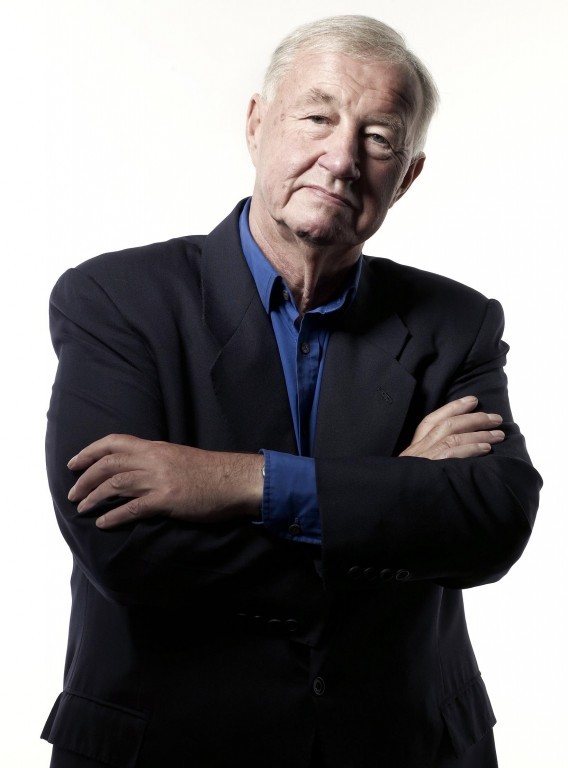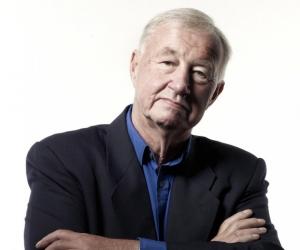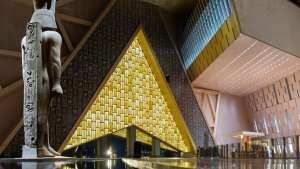First Published in

To hear Sir Terence Conran talk of his professional career is very much to hear the history of British design in the latter half of the twentieth century. And that's not overstating it either. A practicing artisan during the formative years of the UK's post-war reconstruction, Sir Terence's personal biography is one of a long, if not supremely patient, walk to the top. Sean O'Toole spoke to Sir Terence about his extraordinary achievements, asking him how he would like to be remembered one day, as a pioneer or a populist?
Your career spans a momentous epoch in recent British history. Can you talk a bit about your early experiences?
I was a teenager during the war years, a student immediately afterwards and a practising designer in the 1950s. The nation absolutely had to rebuild itself following the war. Interestingly there was quite a small community of designers at that time. There was certainly a feeling of camaraderie, of it being a family, almost an endangered species. We had two projects after the war. The one I was not involved with was called Britain Can Make It, which was put on in the Victoria and Albert Museum. It showcased new thinking about design. The government was actively trying to promulgate an interest in design at the time and even established something called the Council of Industrial Design, which was quite important and run by Gordon Russell, an extremely intelligent man.
But the project I was involved in, which made an enormous impression on me, if not the general public too, was the Festival of Britain. I worked on it as an apprentice for an architect. I did various things such as design and make furniture and textiles. I designed the cabin interior of the Princess Flying Boat, which was a 600-seater flying boat that would supposedly take people all over the world but never really worked. I was also sharing studio space with a sculptor at the time called [Sir] Eduardo Paolozzi [credited with the explosive development in screen printing as a creative medium for artists]. I helped him with a public sculpture for the festival. I even made plastic letters with small fish and crustaceans for the Natural History Pavilion. [Chuckles] I slept on site for six weeks in total before the show opened. I think that nowadays people look back at the South Bank, where the Festival of Britain was staged, and think my god that was extraordinary what happened there.
What was the next highlight after the Festival of Britain?
My experience was that after the festival came, every designer thought they would have golden years and be very much in demand. The truth of the matter was that there were so many shortages that none of the manufacturer had to make their products different, design-wise that is. They could sell everything they were producing in any case. I ended up extremely frustrated - and out of work. My employer had got no work at all, but for a hotel in Lusaka. That was it for me. I was retrenched. I then started making furniture in my own workshop, basically establishing my furniture-making business from these very small beginnings.
Looking back on those early years, were there many sleepless nights?
Working nights, not just sleepless. [Laughs] It was a very, very tough time indeed. I can always remember the sales graph, one year making a profit and the next a loss, then a profit again. Somehow the sales trend, however, gradually went up and by the end of the 1950s, having battled, moving from one scruffy workshop to another bigger but similarly scruffy workshop, we made it. We also gradually moved out of London until finally we left London completely, taking 80 families to Norfolk.
How did you balance vision and design innovation with market demand, which is usually rather conservative by nature?
It was quite interesting. In the early days of our company we did two things. We manufactured furniture and also built exhibitions. Building trade exhibitions, we managed to establish a fully-fledged design company. On the furniture side we were not making for the retail sector, rather for architects, for universities, for hotels, the top echelons really. There was quite a rebuilding programme going on in the UK at the time. Our sort of designs were really suitable for the contract market. In terms of innovation though, it really depended; sometimes people would come along with their own designs, sometimes architects would arrive with drawings asking for a tender on manufacturing an item. We had our own range of commercial products but it depended on the job. Of course we were always innovating in some way or another.
I always remember, in my early days, looking across the Atlantic, across America to the West Coast, admiring everything that was being done by Charles Eames, George Nelson, Knoll, all that energy and success that they were having with commercial furniture design. I read about them in a magazine called Architectural Design; I was absolutely passionate about them. Their activities were a spur to me. I thought, well they are doing that, why shouldn't I do something as good or similar. I wasn't copying them, I was simply inspired by what they were achieving. Everybody needs inspiration. One shouldn't copy, but you must be inspired.
There are, however, relatively few things that one can say are truly original in design. It is usually something that has progressed. I remember, as a trustee of the Victoria and Albert Museum, I was talking about this subject to the keeper of furniture there. I said to him that the plastic moulded chair by Charles Eames was a great innovation in design, as were the Bauhaus cantilever chairs. After stating this the keeper showed me a book with Victorian papier-mâché chairs that were practically the identical shape of the Eames chair. He also showed me a drawing of a railway carriage taking people to work on the mines. On it was a cantilever chair, date 1847, long before the Bauhaus. So what's new in this world?
How does Habitat fit into the equation?
I suppose starting Habitat was my big move forward. I had some spare capacity in my factory in Norfolk at the time, and decided to produce the first range of packed flat furniture made in the UK. We exhibited it at the London Furniture exhibition and got orders from about 80 different retailers. After visiting these retailers, seeing how the furniture was displayed, we returned back to the factory deeply disappointed. Very few of the retailers knew how to display or even assemble it. There was no sense of display either. We thought about getting out of domestic furniture altogether but I said no, let's be cheeky, let's start a shop ourselves and show people how we believe this sort of furniture can be sold, how it can be displayed.
We opened Habitat on Fulham Road. It was immediate success, although a lot of people dismissed it as part of the swinging Chelsea scene. They said it would never work in Manchester or Glasgow, which it did eventually. I think that along with Mary Quant, we wanted to do things that allowed people to make their own decision about the way they would lead their lives. It was a very interesting moment in Britain. Young people, for the very first time in their lives, had some money in their pockets and could make their own decisions about how they dressed, how they lived, their entertainment. They were not in their parent's pockets any longer.
We all know of the successes you achieved with Habitat. Did the success ever blur your personal sense of who you were?
I have always thought of myself as a designer. I have never particularly been interested in the financial aspect of a business. I have always had people in my businesses to run the financial side of it. I was quite surprised recently when a newspaper produced supplement called Greatest Business People of All Time. The minister in charge of the Department of Trade and Industry chaired the group responsible for compiling the list. I ended-up being voted twentieth of all time, and number three amongst the living. Little Terence Conran who I always thought was just a designer, not a terribly good businessman, and there I was. I thought God, what is happening?
Obviously you have also been through many lows too as a designer and businessman. How have you dealt with dips, particularly in the economy?
This is my fourth recession. [Smiles] In some ways a recession allows us to clear the decks a bit. You might make decisions during an expansionary period that are not always the wisest, and you end up fatter than you should be. A recession makes you look at everything again, makes you ask if this or that is really necessary. You have to think, what can we offer that reflects the current problems that people have economically? They're feeling a bit broke, what can we do that recognises that they want to spend less money?
Can you give an example, say from the Conran Shop?
We have a range called Quintessentials, 250 products that are exceptional value for what they are. They are not the cheapest in the market place, but they represent the best value for what they are.
Are you still actively involved in the procurement process?
Absolutely, I attend every merchandising meeting. I am very much interested in the marketing side of the company.
Which probably makes it pertinent to ask you about Sally Story's LOSA range. What were your thoughts the first time you saw the LOSA product range? What intrigued you?
I thought they were a beautiful collection of products. They are craft rather than industrially produced objects. They have a certain a certain aesthetic about them, which looks as if one pair of eyes has put the whole project together. I thought they were more expensive than they needed to be, but that was because they had been through several pairs of hands. I didn't think it was entirely good news for South Africa because they ended up on the shop floor as quite precious products; they weren't Quintessentials. We did email the ostriches asking them to lay more eggs because that could have been a highly quintessential product.
Well-known British designers such as Tom Dixon, Kate Blee and Julia Leakey were involved in the LOSA project. What if a local designer wants to be pigheaded and market a completely original, local design; what advice would you give?
Yeah sure they should stick to it. Determination is very valuable quality in this world. I think determination in designers is enormously important. Look at the determination Alan Fletcher spoke about in his talk yesterday; designers have to have it if they are not going to have compromised products.
Forging a national identity is a big issue in South Africa at the moment. To what extent should the government be involved in the push and pull to forge a national design identity?
I think that South Africa, like many other developing nations, is discovering that it has to innovate in design to add value to products that it wants to export. The government always has a huge budget for public procurement, for buying things for the state. It can be a leader in influence. It can, and should say in my opinion, that we want to see an investment in design; we want to see that the products we are buying with the public purse are intelligently designed. They can act as a great catalyst in getting the industry going.
Somewhat coincidentally, it was an extraordinary thing to learn that quite a number of BMW and Mercedes are made in this country. I didn't know that. My wife owns a BMW that was made in South Africa, although she didn't know this until quite recently. It's a factor that is terribly important; the world should know that these products of great quality are made in this country. It has to be led by government, they have to stand on a soapbox and shout with pride what it is achieving and what it intends achieving.
What would you regard as the markers of British design?
It is very interesting since we just spoke about national characteristics in design. I don't think that anybody in their right mind ever tries to be British, French, German, South Africa. I think you just do it naturally without trying to put a Made in South Africa or Made in Britain stamp on things. It is just about doing it because you are the person you are. I suppose one of the most British artefacts since the war has been the Mini. The people involved in the design were, however, probably looking at the Fiat for inspiration. I am sure they didn't think it was particularly British but the way it was perceived by the world was that it was the absolute epitome of Britishness. Nationalism attaches itself to a product afterwards. I have people telling me that some of my early products are now unmistakably iconic, but what was I telling you a moment ago? My influences were all from the West Coast of the US, or shaped by what I saw at the Milan furniture exhibitions - but filtered through me, coming out with a bit of me in it.
How would you like to be remembered: as a populist or a pioneer?
I think as a popular pioneer actually. [Laughs]
Would you regard yourself as a modernist, maybe a late modernist?
Yes, but perhaps not in that rather severe Bauhaus way. What I have always believed in is trying to bring things that are intelligently designed to as big a market as possible. This means they must be priced at a level that the majority of people can afford. I have always believed that people's taste is formed by what they are offered; if they are not offered something how the hell do they know they want it?
We haven't even touched on your restaurant empire. Maybe it's appropriate simply to end by asking what your favourite dish is at the moment?
I have just done a book with my wife Vicky called Plain, Simple and Satisfying Food. It is meant to be a recognition that the quality of ingredients should be the most important thing about food - not the chef. So what is my favourite dish? It might just be a dish of tomatoes with a bit of olive oil with a bit of rock salt sprinkled over.








